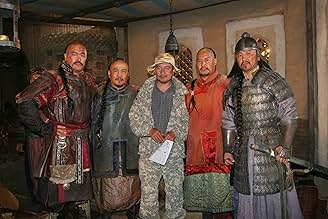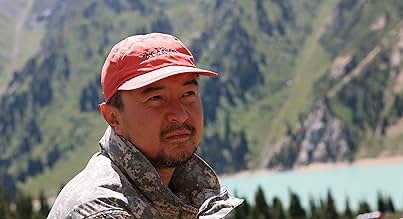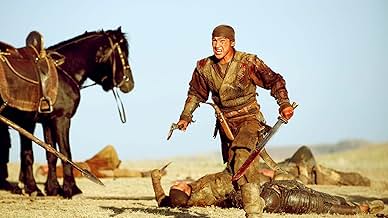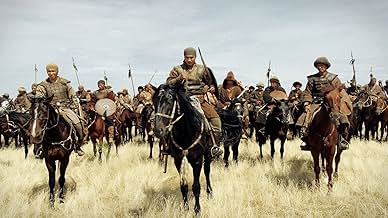Ajouter une intrigue dans votre langueA universal story about the freedom of the human spirit and the struggle against slavery and despotism, about love, loss and betrayal. It is seen through the eyes of simple Kazakh kids and t... Tout lireA universal story about the freedom of the human spirit and the struggle against slavery and despotism, about love, loss and betrayal. It is seen through the eyes of simple Kazakh kids and teenagers.A universal story about the freedom of the human spirit and the struggle against slavery and despotism, about love, loss and betrayal. It is seen through the eyes of simple Kazakh kids and teenagers.
- Réalisation
- Scénario
- Casting principal
- Récompenses
- 2 victoires au total
Ayan Utepbergen
- Taimas
- (as Ayan Utepburgen)
Toleubek Aralbaev
- Rakhimjan
- (as Toleubek Aralbai)
Tungyshpai Zhamankulov
- Yesset Batyr
- (as Tungyshpai Al-Tarazi)
Avis à la une
Watching "Zhauzhürek myng bala" -- also known as "Warriors of the Steppe" -- was a moving experience. It was also a novel experience, since I had never seen a movie from Kazakhstan -- and I gather most people haven't.
First, this is incredibly well done, with magnificent directing and camera work. The scenery is breath-taking. The scope of the story is more than fascinating.
Usually I have a problem keeping up with such a movie because of the chore of reading subtitles, but not this time.
The story itself reminds me a bit of "Taras Bulba," a conquered people trains itself to re-take its homeland.
The horsemanship also grabbed my admiration, and added to the acting, the directing, the superb cinematography, it totaled a motion picture experience I have not equaled in a very long time.
This movie is one to watch again and again. It's available on YouTube and I highly recommend it.
I also thank the reviewer of 30 November 2013 who was able to speak from personal experience of the beauty of Kazakhstan. You made watching this movie even better.
First, this is incredibly well done, with magnificent directing and camera work. The scenery is breath-taking. The scope of the story is more than fascinating.
Usually I have a problem keeping up with such a movie because of the chore of reading subtitles, but not this time.
The story itself reminds me a bit of "Taras Bulba," a conquered people trains itself to re-take its homeland.
The horsemanship also grabbed my admiration, and added to the acting, the directing, the superb cinematography, it totaled a motion picture experience I have not equaled in a very long time.
This movie is one to watch again and again. It's available on YouTube and I highly recommend it.
I also thank the reviewer of 30 November 2013 who was able to speak from personal experience of the beauty of Kazakhstan. You made watching this movie even better.
Myn Bala the Kazakh movie Well, first movie I've ever seen on IMDb with only one review (three now, since I wrote this). It's the supposedly uplifting legend, based on a true story, of a set of young rebels early in eighteenth Century Kazakhstan who rose up against their oppressors. The country at that time was being overrun by a cruel and violent militaristic set of people called the Djongars, who were descendants of Genghis Khan and his Mongols. There are two main young male protagonists, Sertai and Taimas, who inevitably fall out as Sertai becomes more admired and takes over leadership; their kind-of-sister and lifelong friend Korlan, who is a scar-faced female warrior and very convincing she is too; and then Sertai falls for the beautiful young daughter, Zere, of a chief whom he offends, as being too conciliatory with their conquerors and not bold enough. The story is well told, though the flow is sometimes lost in translation. Mainly because the subtitles are out of synch, or use peculiar modern slang idioms, or during three long character farewell speeches leave just one (non-English) word up on screen for five minutes. Still, you get the gist. The story isn't new: Braveheart and all that - but this one has three things that make it standout (even apart from the fact that know nothing whatsoever about Kazakhstan's history so is always good to see a different part of the world through fresh eyes). The three things are:
The steppe. Every so often the main characters wander down from the hills where they're hiding and say something like: oh, our steppe is so beautiful, we must get rid of the invaders. They almost literally swoon over the beauty of the steppe. Really extraordinary: rarely have I seen a place which gives the western city-born person such a sense of otherness - great empty wild bare barren looking place - kind of makes me feel the opposite. The clothes. Presume they are all true to time for the place and period. Great fur hats cascading down backs, women's hats like pagodas, intricate tooled soft leather jerkins and belts, Tartar-ish military uniforms look rather like samurai - completely unlike anything have seen before. The horse-riding. Never seen anything like it in the movies: these people ride like they were born in the saddle. And why walk when you can trot? And why trot when you can gallop hell for leather across endless miles of steppe? So gallop they do. A lot. So very enjoyable. Only downside: the end. And being told that it was another three hundred years before Kazakhstan finally got its freedom. Which would be .... hm, sometime in the 1990s.
The steppe. Every so often the main characters wander down from the hills where they're hiding and say something like: oh, our steppe is so beautiful, we must get rid of the invaders. They almost literally swoon over the beauty of the steppe. Really extraordinary: rarely have I seen a place which gives the western city-born person such a sense of otherness - great empty wild bare barren looking place - kind of makes me feel the opposite. The clothes. Presume they are all true to time for the place and period. Great fur hats cascading down backs, women's hats like pagodas, intricate tooled soft leather jerkins and belts, Tartar-ish military uniforms look rather like samurai - completely unlike anything have seen before. The horse-riding. Never seen anything like it in the movies: these people ride like they were born in the saddle. And why walk when you can trot? And why trot when you can gallop hell for leather across endless miles of steppe? So gallop they do. A lot. So very enjoyable. Only downside: the end. And being told that it was another three hundred years before Kazakhstan finally got its freedom. Which would be .... hm, sometime in the 1990s.
Kazakhstan is fortunate in having a historical enemy to depict as bad guys without any concern for offending them, since the Dzungar Khanate went out of existence in the mid-18th century, not long after the events of this film. The exterminator of the Dzungar Khanate was of course Qing-dynasty China on their eastern front. That fact is barely mentioned in passing when Sultan Abilkhair points to his map and says the Dzungars have been cut off in the east. That was China making war on them. That Kazakhstan raised a rebel army strong enough to take on the western front in the Dzungar Wars is the stuff of epic legend. The scene right before the climactic battle has various divisions announcing their representation of all different parts of Kazakhstan. This is perfect for raising patriotic feeling over Kazakh history, while there are no remaining Dzungars to take offense at being shown as the unremittingly bad guys. What was then Dzungaria is now part of Xinjiang and is inhabited by Uyghurs, Kazakhs, Manchus, and Mongols as well as Chinese. It is at peace with independent Kazakhstan. This movie cast the Kazakhs in earth tones, mostly shades of brown, while the Dzungars are uniformly in black. The story is simple and easy to follow even without knowledge of this era of Kazakh history. A band of plucky teenagers becoming heroes of their nation. Go see it and feel good for Kazakhs.
I have had the privilege to see Kazakhstan many times. This movie showed the world the great natural beauty of Kazakstan, the mountains, prairies, and the people. The steppes as pictured had to be filmed in the actual steppes of the Tin Shin mountains, these scenes brought back great memories of this beautiful country. The villages had to be actual original habitats as you can see in the Mueseum in Almaty. The casting for this movies is absolutely wonderful. The Kazak language was refreshing to hear. This movie captured my heart as memories were resurrected from my heart. I thank the group that produced this movie and for their depiction of so many accurate descriptions through the art of cinematography. I recommend this movie for any one that loves freedom and I appreciate the culture of the Kazaks and their honorable approach to friendship as aptly presented in this wonderful movie based on their recent history. May Kazahstan remain free.
this film was beautifully done in every way. good cast, good directing, good screenplay, good camera, good editing, beautiful locations and settings, good costumes and, very good music. i've never thought a movie out of a small central Asia country would be this good. the script was so well crafted that allowed the young heroes and heroines to freely perform with their hearts and spirits. this is a film that once you've watched it would always stay with you, the beautiful prairie, the remote snowy mountains, the horses, the galloping. the first viewer was right, this film is indeed much better than 'nomad', the fight scenes were especially good too.
Le saviez-vous
- AnecdotesThe official submission of Kazakhstan to the Best Foreign Language Film of the 85th Academy Awards 2013.
Meilleurs choix
Connectez-vous pour évaluer et suivre la liste de favoris afin de recevoir des recommandations personnalisées
Détails
Box-office
- Budget
- 12 000 000 $US (estimé)
- Montant brut mondial
- 2 172 $US
- Durée
- 2h 12min(132 min)
- Couleur
Contribuer à cette page
Suggérer une modification ou ajouter du contenu manquant








